
Water Quality in the Western Lake Michigan Drainages, Wisconsin and Michigan, 1992-95
Table of contents || Previous section || Next section || Glossary
WATER QUALITY CONDITIONS IN A NATIONAL CONTEXT
|| Surface water || Ground water ||
Comparison of Ground Water Quality in the Western Lake Michigan Drainages with Nationwide NAWQA Findings
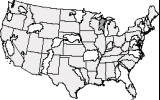 (3,097 bytes) (3,097 bytes)
|
Five major water-quality characteristics were evaluated for ground-water studies in each NAWQA Study Unit. Ground-water resources were divided into two categories: (1) drinking-water aquifers and (2) shallow ground water underlying agricultural or urban areas. Summary scores were computed for each characteristic for all aquifers and shallow ground-water areas that had adequate data. Scores for each aquifer and shallow ground-water area in the Western Lake Michigan Drainages were compared with scores for all aquifers and shallow ground-water areas sampled in the 20 NAWQA Study Units during 1992-95. Results are summarized by percentiles; higher percentile values generally indicate poorer quality compared with other NAWQA ground-water studies. Water-quality conditions for each drinking-water aquifer also are compared to established drinking-water standards and criteria for protection of human health. (Methods used to compute rankings and evaluate standards and criteria are described by Gilliom and others, in press.)
|
EXPLANATION
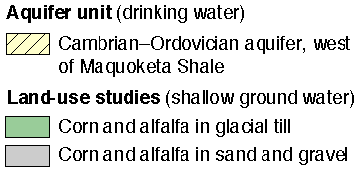
Ranking relative to national conditions-- Darker colored circles generally indicate poorer quality. Bold outline of circle indicates one or more drinking-water standards or criteria were exceeded.
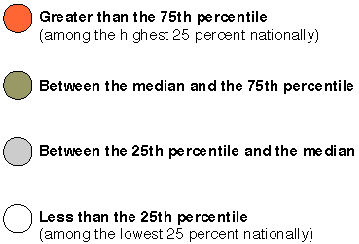
|
 (5,118 bytes) (5,118 bytes) |
RADON
Radon levels for the Cambrian-Ordovician aquifer ranked relatively high among the national NAWQA sites. A natural product of the decay of uranium, radon is a radioactive gas that was detected in all samples collected from the Cambrian-Ordovician aquifer. Two-thirds of the samples exceeded a previously proposed maximum contaminant level of 300 picocuries per liter, although few samples in the southwestern part of the aquifer had high concentrations. The lack of data restricts the ability to speculate about the presence of radon in the shallow aquifers.
|
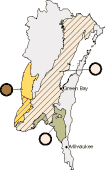 (5,583 bytes) (5,583 bytes) |
NITRATE
Nitrate concentrations in the shallow-aquifer area underlain by sand and gravel are some of the highest among the NAWQA sites nationwide, probably because highly permeable surficial deposits allow agriculturally derived nutrients to infiltrate to the ground water. The Cambrian- Ordovician drinking-water aquifer and the shallow aquifer overlain by glacial till both had low concentrations of nitrates compared to other national NAWQA data. All three areas had a few samples in which nitrate concentrations exceeded the drinking-water standard, a common occurrence in the Midwest farm belt.
|
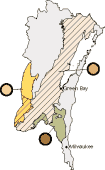 (5,658 bytes) (5,658 bytes) |
DISSOLVED SOLIDS
Concentrations of dissolved solids were relatively high compared to those in other Study Units. A few samples from each aquifer had concentrations of dissolved solids that exceeded the secondary maximum contaminant level. However, the shallow aquifers are seldom used as a drinking-water source. The area overlain by glacial till had among the highest concentrations of dissolved solids compared to other NAWQA sites nationally.
|
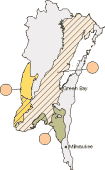 (5,415 bytes) (5,415 bytes) |
VOLATILE ORGANIC COMPOUNDS
There was only one VOC (Trihalomethanes) detected in the Study Unit, and VOC concentrations at the two wells where detected were low. None of the samples tested above drinking-water standards. Industrial by-products and some pesticides are potential sources of VOCs in ground water.
|
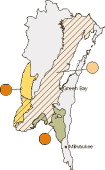 (5,464 bytes) (5,464 bytes) |
PESTICIDES
Pesticide detections in the Cambrian-Ordovician aquifer were similar to the median value from NAWQA sites; however, pesticide concentrations were high in both land-use study areas compared to aquifers in other Study Units. None of the ground-water samples exceeded drinking- water standards for pesticides; however, maximum contaminant levels (MCLs) have been established for only a small percentage of the pesticides detected.
|
CONCLUSIONS
In the Western Lake Michigan Drainages, compared to other NAWQA Study Units:
- Nitrate and pesticide concentrations in shallow wells in agricultural areas were elevated; in areas with permeable surficial deposits, they were among the highest in the Nation.
- Drinking-water standards were exceeded in a few samples in each of the three ground-water study areas for nitrates and dissolved solids.
- Radon was elevated above the previously proposed maximum contaminant level in the drinking-water aquifer where it was sampled for.
- Land use is the primary influence on ground-water quality, whereas surficial deposits overlying an aquifer have a secondary influence. The confining unit overlying parts of the Cambrian-Ordovician aquifer provides some protection of the drinking water from the effects of human activities.
|
U.S. Geological Survey Circular 1156
Table of contents || Previous section || Next section || Glossary
Suggested citation:
C. A. Peters, D. M. Robertson, D. A. Saad, D. J. Sullivan, B. C. Scudder, F. A. Fitzpatrick, K. D. Richards, J. S. Stewart, S. A. Fitzgerald, and B. N. Lenz, 1998, U.S. Geological Survey Circular 1156, on line at <URL: https://water.usgs.gov/pubs/circ1156>, updated June 11, 1998